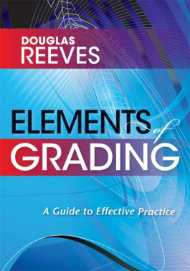Elements of Grading: A Guide to Effective Practice
Elements of Grading: A Guide to Effective Practice
By Douglas Reeves
(Solution Tree Press, 2011 – Learn more)
Contributing to the national conversation and debate about the role of grading and the nature of long-standing assessment practices in the United States, Douglas Reeves’ Elements of Grading offers well-researched, practical insights that can be used to further assessment reform efforts. Of course, being familiar with Dr. Reeves’ work, I wouldn’t expect anything less!
The Four Essentials, Amplified

With a chapter dedicated to each of these topics, Reeves thoroughly explores each, provides explicit examples to communicate his points, and offers alternative grading strategies for consideration. I was excited to see him blend Carol Dweck’s important work about motivation and intelligence into his recommendations for effective practice.
Throughout the book, Reeves uses clear examples and compelling arguments to support his thoughts and ideas. While I’ve been actively engaged in the national conversation about grading reform (specifically on Twitter with the Standards Based Grading conversation and definitely in following Rick Wormeli’s thinking), there were many new ideas in Elements of Grading that expanded my understanding and propelled my work. That said, I did find some of Reeves’ examples far-fetched, over-reaching or unnecessary. These sometimes lengthy diversions (e.g., a comparison between grading and the TV show House) do offer some valid points but distract from the main narrative.
Beyond the Usual Grading Conversation
While many other resources I’ve viewed on this same topic point out the fallacies of our current grading system, I have not encountered too many alternate suggestions beyond the broad notion of “standards based grading.” Douglas Reeves’ work begins to address this gap.
At least two of his strategies caught my attention as new and, importantly, completely do-able from a teacher and administrator perspective. In particular, I love his idea to maintain an A-B-C-D/F system, but to get away from calculating the average. He suggests a model that establishes a high standard for success and is transparent for students/parents. Another favorite was the assessment menu that allows students to mix and match assignments t to demonstrate their knowledge of a topic/course while also benefiting from academic choice and the differentiation inherent in the activities. (Read more about Reeves’ menu ideas in this ASCD article.)
An A+ for Accessibility
This book got my attention and made me think. My copy is now laced with sticky notes and highlighted passages and my to-do list has a few new action steps that came directly from The Elements of Grading.
The critical question that Reeves raises is whether “students, teachers, and parents can use the feedback from the grading system to improve performance (pg. 123).” If all educators were to pause and reflect on this question, our nation’s conversation about grading would be propelled further exponentially in no time!
This book could be used as a quick way to launch a school faculty into important conversations about current practice — and to consider a few possible strategies for improvement that meet Dr. Reeves’ litmus test for accuracy, fairness, specificity, and timeliness.
Overall (birdwalks around House notwithstanding), Elements of Grading: A Guide to Effective Practice is a straightforward and quick read that is easily digestible, thought-provoking and very timely. It spawned new thinking that will lead to actionable ideas as I continue conversations about grading with my staff and school community. Reeves’ book contributes greatly to the current local and national conversation about the need for grading reforms in schools.
Rachel Amstutz is an elementary school principal in Maryland. She is a National Board Certified teacher and a doctoral candidate student. Passionate about all things related to education, Amstutz is currently interested in mathematics education, policy, education reform, the uses social media in education, and international education. She lives close to the Chesapeake Bay and loves to take her Labs for walks in the local parks. Follow her on Twitter @rachelamstutz.



































